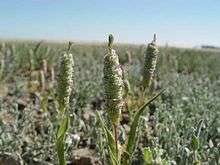Neostapfia
| Colusa grass | |
|---|---|
 | |
| Scientific classification | |
| Kingdom: | Plantae |
| Clade: | Angiosperms |
| Clade: | Monocots |
| Clade: | Commelinids |
| Order: | Poales |
| Family: | Poaceae |
| Subfamily: | Chloridoideae |
| Tribe: | Cynodonteae |
| Subtribe: | Orcuttiinae |
| Genus: | Neostapfia Burtt Davy |
| Species: | N. colusana |
| Binomial name | |
| Neostapfia colusana | |
| Synonyms[2] | |
| |
Neostapfia is a genus of endemic Californian bunchgrasses, in the Chloridoideae subfamily of the Poaceae (grass) family. [3] [1][4][5][6] The only known species is Neostapfia colusana, with the common name Colusa grass.[1]
Distribution
Neostapfia colusana is endemic to the Central Valley of California, in the northern section's Sacramento Valley and in the southern section's San Joaquin Valley. [1] The bunchgrass grows in vernal pools, which are seasonal shallow freshwater ponds.
It is native to the Central Valley counties of Glenn, Colusa, Yolo, Solano, Stanislaus, and Merced. [7] [8]
This rare grass is a federally listed threatened species in the United States.[9] [3]
Description
Neostapfia colusana is a clumping bunchgrass with distinctive cylindrical inflorescences covered in flat spikelets.
The inflorescences are said to resemble tiny ears of corn. They fruit in grains covered in a gluey secretion, and when a plant is mature each clump becomes brown and sticky with the exudate.
The genus was named for the botanist Otto Stapf.
Conservation
The plant is limited to vernal pool habitats, a type of ecosystem which is increasingly rare as Central Valley land is consumed by development and agriculture, and damaged by flood control regimes and other alterations of hydrology.[10]
References
- 1 2 3 4 Jepson (JM2): Neostapfia colusana
- ↑ Kew World Checklist of Selected Plant Families
- 1 2 USDA: Neostapfia colusana
- ↑ Davy, Joseph Burtt. 1898. "Stapfia, a new genus of Meliceae, and other noteworthy grasses." Erythea 6 (11): 109-113, text.
- ↑ Davy, Joseph Burtt. 1898. "Stapfia, a new genus of Meliceae, and other noteworthy grasses." Erythea 6 (11): plate 1, line drawings of Neostapfia colusana, named as Stapfia colusana
- ↑ Davy, Joseph Burtt 1899. "Concerning Stapfia." Erythea 7 (43)
- ↑ Calflora Database: Neostapfia colusana, with county distribution maps.
- ↑ Biota of North America Program 2013 county distribution maps for Neostapfia colusana
- ↑ The Calflora Database: Information on California plants for education, research and conservation, with data contributed by public and private institutions and individuals, including the Consortium of California Herbaria. 2015. Berkeley, California
- ↑ California Native Plant Society Rare Plant Profile
